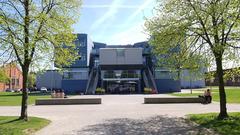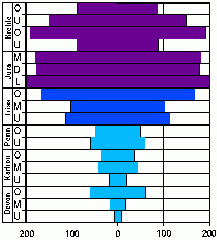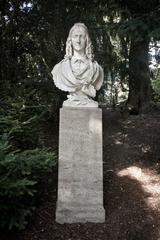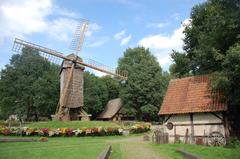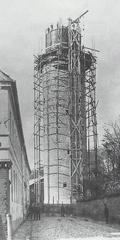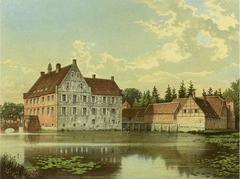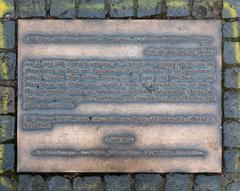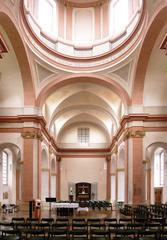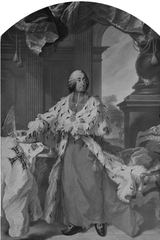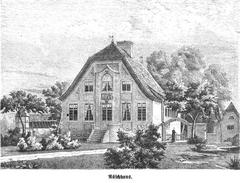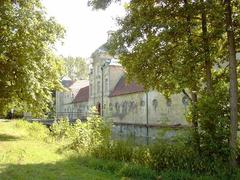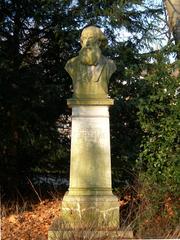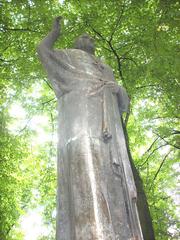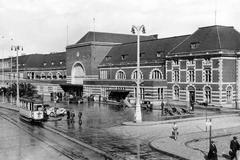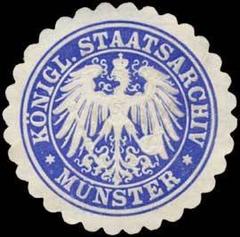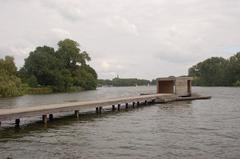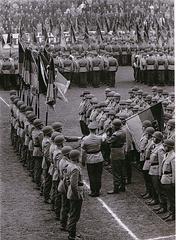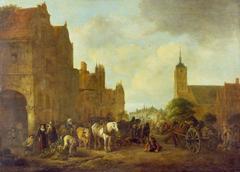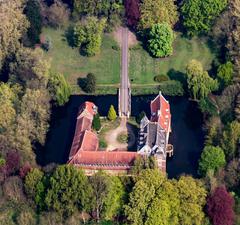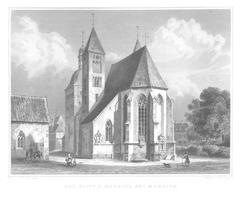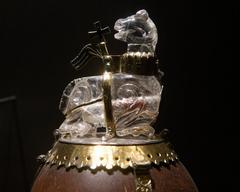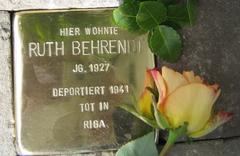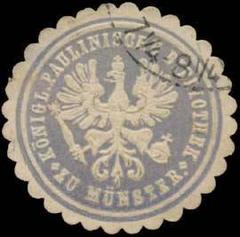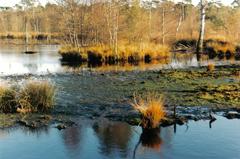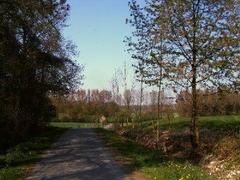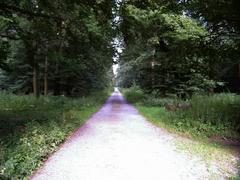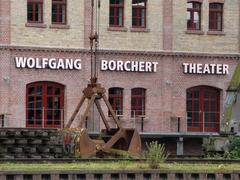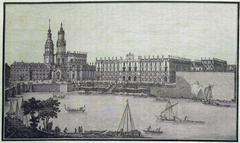Albachten Visiting Guide – Münster, Germany
Date: 04/07/2025
Introduction: Discover Albachten’s Distinctive Character
Albachten, located on the southwestern outskirts of Münster, is a district that beautifully unites centuries-old history with a vibrant, welcoming community. First referenced in the 12th century and now fully integrated into the city of Münster, Albachten is known for its preservation of Westphalian rural traditions, architectural highlights such as St. Ludgerus Church, and an array of annual festivals. This guide provides a comprehensive overview for visitors—covering Albachten’s historical significance, cultural life, practical information on visiting hours and tickets, accessibility, travel tips, and recommendations for making the most of your visit (audiala.com; wiki.muenster.org).
Table of Contents
- Early History and Medieval Foundations
- Integration into Münster
- Religious and Cultural Heritage
- Traditions and Community Life
- Architectural and Historical Landmarks
- Albachten in the 20th Century
- Modern District Life
- Visitor Information: Getting There, Hours, Tickets, Accessibility, Guided Tours
- Notable Annual Events
- FAQs About Visiting Albachten
- Photographic Highlights and Media
- Related Sites and Planning Resources
- Summary and Final Tips
- References
Early History and Medieval Foundations
Albachten’s origins trace back to at least the 12th century, with archaeological evidence suggesting settlement even earlier due to fertile lands and proximity to Münster’s medieval trade routes. The name “Albachten” is believed to derive from Old Saxon, typical of regional naming customs. In the Middle Ages, Albachten existed as a small rural settlement under the Prince-Bishopric of Münster, developing alongside the city’s rise as a Hanseatic and ecclesiastical center (audiala.com).
Integration into Münster
Once part of the Amt Roxel, Albachten was incorporated into Münster during the administrative reforms of 1975 (Wikipedia). This transition facilitated improved infrastructure and closer ties with Münster’s urban core while allowing Albachten to retain its distinctive rural character.
Religious and Cultural Heritage
The spiritual and cultural heart of Albachten is the neo-Gothic St. Ludgerus Church, dedicated to Münster’s first bishop. The church, founded on the site of medieval predecessors, has been a center for community worship, music, and gatherings for centuries (kirche-mswest.de). Its role extends beyond the religious sphere, hosting events like the annual Christmas concert and serving as a site of collective remembrance during national days of mourning (Bläservereinigung Albachten).
Traditions and Community Life
Albachten’s community spirit is vibrant, maintained by longstanding traditions and local associations. Key events include:
- Schützenfest: A marksmen’s festival featuring parades, music, and the crowning of the Schützenkönig (Bläservereinigung Albachten).
- Osterfeuer: The Easter Fire, symbolizing the arrival of spring and drawing large crowds (wn.de).
- Stadtteil-Flohmarkt: A bustling neighborhood flea market (wn.de).
Associations like the Bläservereinigung Albachten and music schools keep the musical tradition alive, and the Haus der Begegnung (House of Encounter) functions as a cultural hub (kirche-mswest.de).
Architectural and Historical Landmarks
- St. Ludgerus Church: Completed in 1884, this neo-Gothic church is the district’s best-known landmark. Its interiors feature a 13th-century baptismal font and crucifix, ribbed vaults, and stained-glass windows.
- Ruhr Manor (Ruhrhof): While not open to the public, the manor’s exterior and surrounding buildings exemplify Albachten’s agricultural heritage.
- Historic Farmhouses: Timber-framed structures and street names like “Haus Wiek” and “Osthof” preserve Albachten’s rural past (wiki.muenster.org).
Albachten in the 20th Century
Although Münster suffered heavy bombing during World War II, Albachten remained largely unscathed (explorial.com). Postwar, the district absorbed refugees and underwent significant expansion, increasing its population and accelerating urban development. Later modernization efforts were balanced with a renewed emphasis on preserving Albachten’s village character (kirche-mswest.de).
Modern District Life
Now home to around 6,500 residents, Albachten offers the best of both worlds: a tranquil, tight-knit community with easy access to Münster’s city center. Residents and visitors benefit from modern amenities, active clubs, and scenic walking and cycling trails. Annual events and local legends, such as the playful story of Bishop Liudger and the “Baccanten,” foster a strong local identity (wiki.muenster.org).
Visitor Information
Getting There
- By Train: Take the RB 63 regional train from Münster Hauptbahnhof to Albachten Bahnhof (about 10 minutes). Trains run twice an hour; check Deutsche Bahn for current schedules.
- By Bus: Lines 15 and 16 connect Albachten to Münster city center; tickets can be purchased via mobil.nrw or from the driver.
- By Car: Accessible via B54 and A1; parking is free and widely available.
- By Bicycle: Dedicated bike paths connect Albachten to Münster, perfect for scenic rides (Tourism on the Edge).
Visiting Hours and Tickets
- Albachten District: Open at all hours.
- St. Ludgerus Church: Open from 9:00 AM to 6:00 PM daily. Free admission; donations are welcome (kirche-mswest.de).
- Guided Tours: Available for groups by prior arrangement with the church office.
- Other Sites: Most attractions are accessible year-round; check local event calendars for opening hours during festivals.
Accessibility
Albachten Bahnhof, the church, and the Haus der Begegnung are wheelchair accessible. Sidewalks and paths accommodate visitors with mobility needs. For detailed accessibility information, contact the Münster Tourist Information Centre.
Notable Annual Events
- Schützenfest: Late August or early September (Bläservereinigung Albachten)
- Osterfeuer: Easter Sunday (wn.de)
- Christmas Concerts: At St. Ludgerus Church
- Stadtteil-Flohmarkt: Annual neighborhood flea market (wn.de)
- Other Events: For schedules, see the Bläservereinigung Albachten events calendar.
Photographic Highlights and Media
Capture Albachten’s essence through:
- Photos of St. Ludgerus Church and traditional farmhouses
- Community festivals and markets
- Walking and cycling trails
Interactive maps and visual guides are available on Münster Tourism.
Nearby Attractions
- Burg Hülshoff: Home of poet Annette von Droste-Hülshoff
- Münster City Center: Prinzipalmarkt, St. Paulus Dom, Picasso Museum
- Aasee Lake: Boating, picnicking, and birdwatching
- Neighboring Villages: Roxel, Bösensell, and Amelsbüren for further exploration
Practical Tips
- Accommodation: Albachten is mainly residential; stay in Münster for a wider selection of hotels and guesthouses (Booking.com, Airbnb).
- Dining: Sample Westphalian cuisine at local restaurants or explore the diverse culinary scene in Münster.
- Language: German is the main language; basic English is spoken in Münster, less so in Albachten. Learning simple German phrases is appreciated.
- Money: Carry some cash for small purchases; most places accept cards.
- Seasonal Advice: Late spring to early autumn (May–September) is ideal for visiting. Winters are cold and damp.
- Connectivity: Free Wi-Fi is more common in Münster than Albachten; consider a local SIM card.
- Sustainability: Use public transport or cycle, follow recycling rules, and respect local etiquette (Germany Footsteps).
Frequently Asked Questions (FAQs)
Q: Do I need a ticket to visit Albachten or St. Ludgerus Church?
A: No, both are free to visit. Guided tours may require advance arrangements.
Q: Is Albachten accessible for visitors with disabilities?
A: Yes, major public spaces and transport hubs are accessible.
Q: How do I get to Albachten from Münster?
A: Take the RB 63 train or bus lines 15 and 16; cycling is also a great option.
Q: What are the best times to visit?
A: Spring and summer, when the weather is pleasant and festivals are frequent.
Q: Are there family-friendly events?
A: Yes, especially the Osterfeuer and flea market.
Summary and Final Tips
Albachten is a district where history, tradition, and modern living blend seamlessly. Its accessible location, welcoming community, and preserved rural charm make it an ideal destination for those seeking to experience Münster’s heritage beyond the city center. Whether attending a lively festival, exploring architectural landmarks, or cycling through the countryside, visitors will find Albachten both authentic and memorable (Bläservereinigung Albachten; Münster Tourism; kirche-mswest.de).
For up-to-date schedules, travel tips, and guided tours, check official resources or download the Audiala app. Plan your visit and immerse yourself in Albachten’s unique Münsterland spirit!
References
- Exploring Albachten: Visiting Hours, Events, and Historical Sites in Münster (https://audiala.com/en/germany/munster), 2025
- Albachten Wikipedia Page (https://de.wikipedia.org/wiki/Albachten), 2025
- Bläservereinigung Albachten Events Calendar (https://blaeservereinigung-albachten.de/bva_termine.html), 2025
- Visiting Albachten: History, Events, and Cultural Highlights in Münster (https://wiki.muenster.org/index.php/Albachten), 2025
- St. Ludgerus Church Official Site (https://www.kirche-mswest.de/ludgerus/), 2025
- Münster Tourism Official Website (https://www.muenster.de/tourismus), 2025
- Visiting Albachten: Historical Sites, Attractions, and Practical Tips for Tourists (https://web.muenster.de/albachten.html), 2025
- Albachten Visitor Guide: Transport, Accommodation, and Travel Tips for Münster’s Historic District (https://www.muensterland.com/en/tourism/orte-muensterland/places-in-munsterland/munster/events-in-munster/), 2025
